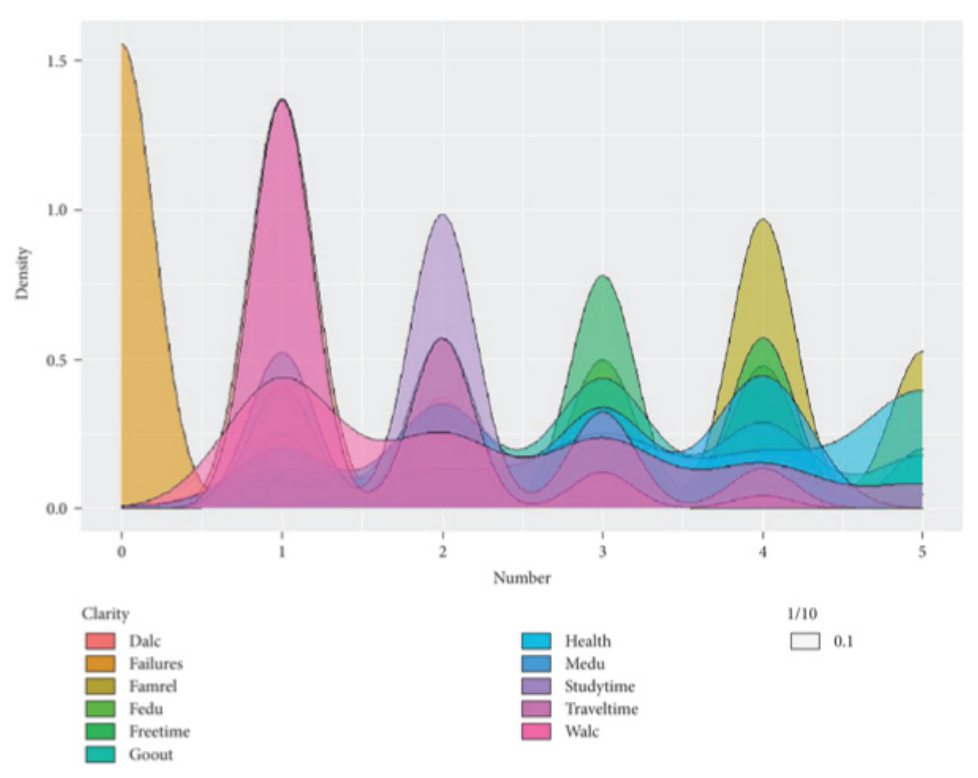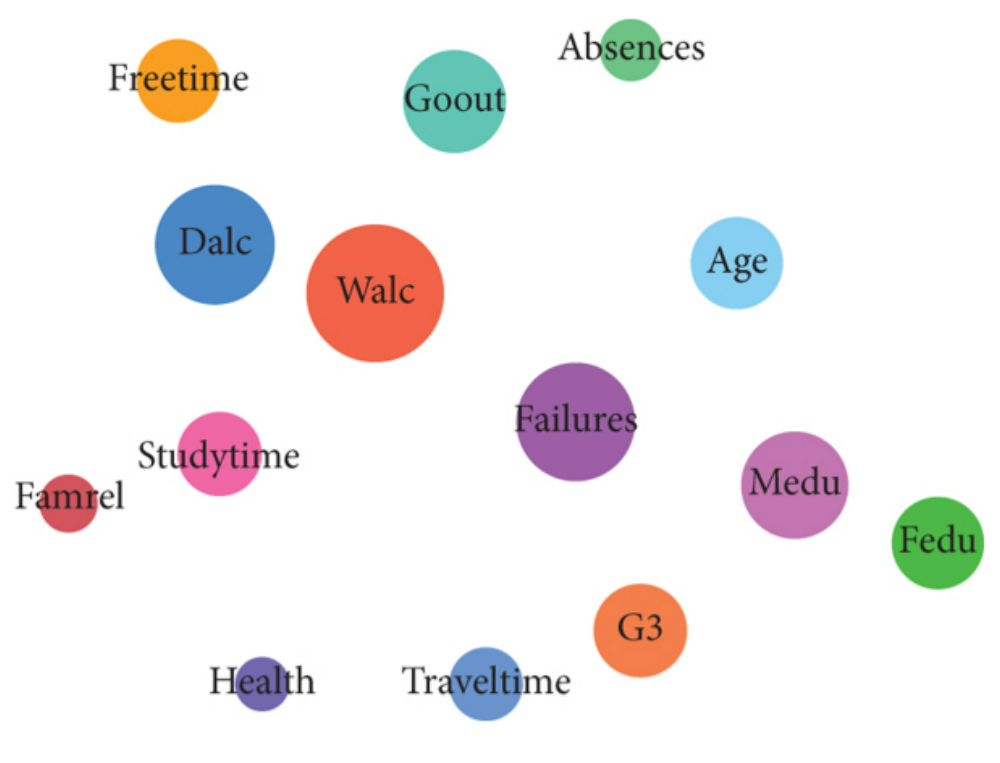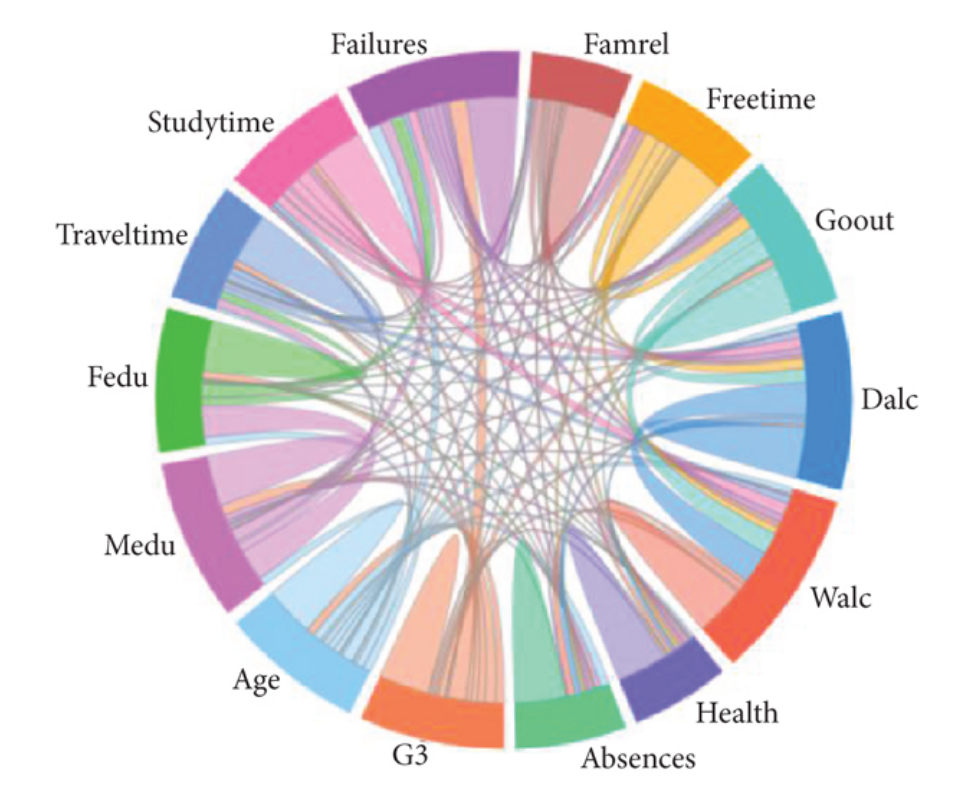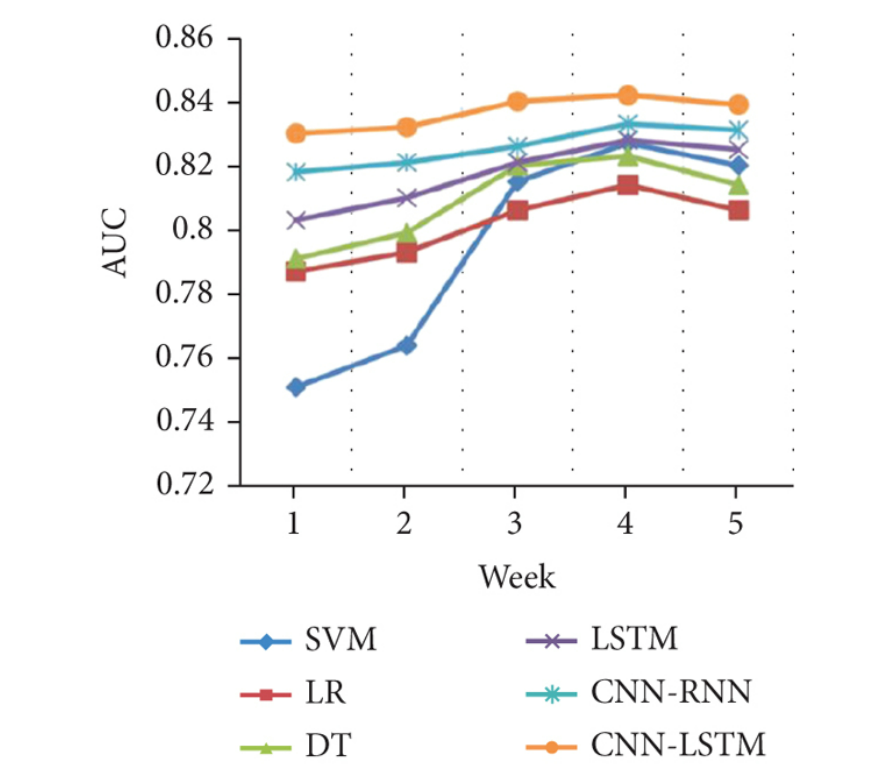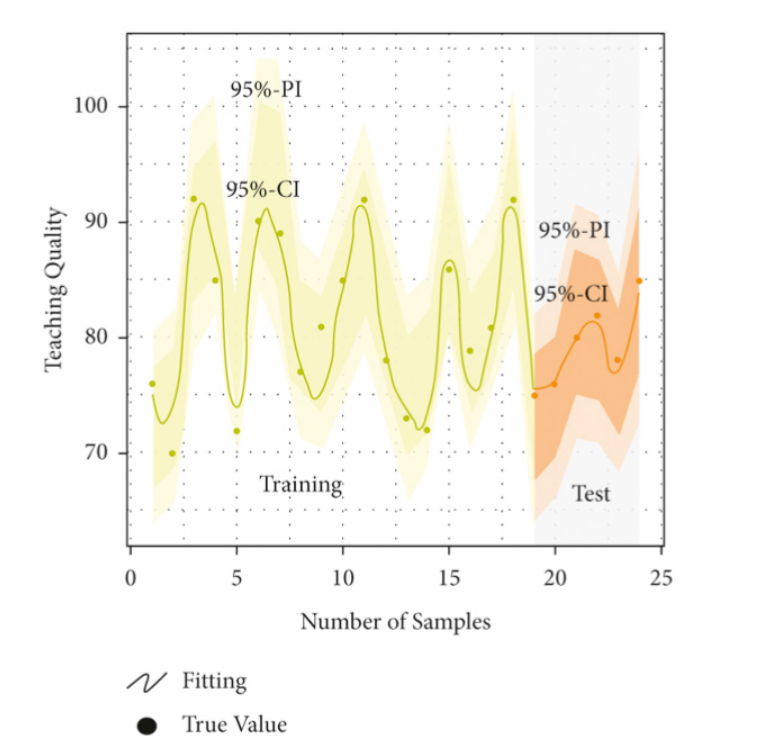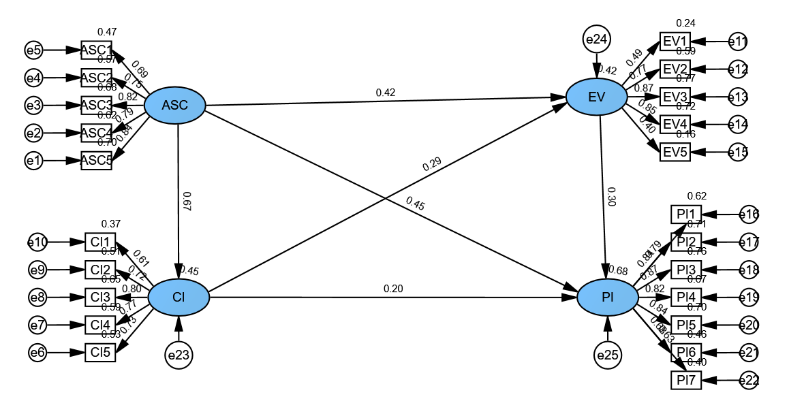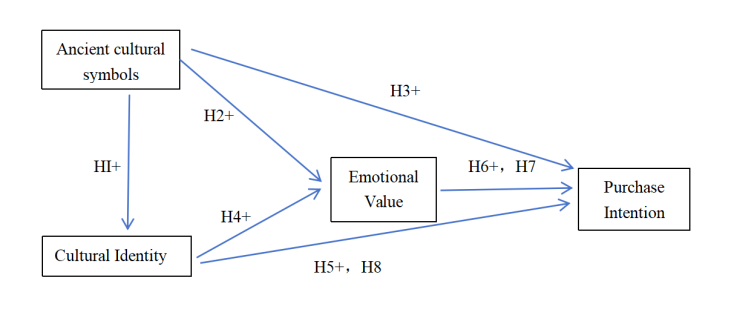 An open access journal
An open access journal
The Impact of Cultural Identity on Consumer Purchase Intention for Leisurewear Incorporating Dunhuang Mural Elements
Abstract
As an ancient cultural element, Dunhuang murals have strong historical and cultural inheritance significance. This study explores the impact of cultural identity on consumers' purchase intention, which has certain theoretical significance and practical value.Based on the existing literature on ancient culture and cultural identity, this study proposes a new research framework based on the theory of planned behavior (TPB) to empirically test the relationship between ancient cultural symbols, cultural identity, emotional value and consumer purchase intention. relation. By analyzing the collected data through structural equation modeling (SEM), the study draws the following conclusions: First, ancient cultural symbols significantly enhance an individual’s sense of cultural identity and emotional value perception, thereby significantly affecting their purchase intention; second, ancient cultural symbols There is a direct or indirect positive correlation between cultural symbols and consumers' purchase intention through cultural identity and emotional value. Cultural identity also has a direct or indirect positive impact on consumers' purchase intention through emotional value; finally, ancient cultural symbols pass through The chain mediation effect of cultural identity and emotional value has a significant positive impact on purchase intention. In summary, ancient cultural symbols not only directly enhance cultural identity, emotional value and purchase intention, but also indirectly affect purchase intention through the intermediary effects of cultural identity and emotional value. The research results provide empirical basis for the use of traditional cultural symbols in product design and marketing strategies. In particular, they provide theoretical support for the marketing strategy of Dunhuang mural casual clothing, which helps to enhance consumers' cultural identity and purchase intention.
Show Figures
Share and Cite
Article Metrics
References
- Ajzen, I. (1991). The theory of planned behavior. Organizational Behavior and Human Decision Processes, 50, 179-211. doi:10.1016/0749-5978(91)90020-T.
- Amos, C., Holmes, G., & Strutton, D. (2008). Exploring the relationship between celebrity endorser effects and advertising effectiveness: A quantitative synthesis of effect size. International Journal of Advertising, 27(2), 209–234.
- Alperstein, N. M. (2019). Celebrity and mediated social connections. London, UK: Palgrave Macmillan.
- Atkin, A. (2022). Peirce's theory of signs as a foundation for pragmatism. Stanford: Metaphysics Research Lab.
- Balasubramanian, S. K., Karrh, J. A., & Patwardhan, H. (2006). Audience response to product placements: An integrative framework and future research agenda. Journal of Advertising, 35(3), 115–141.
- Bazeley, P., & Jackson, K. (Eds.). (2013). Qualitative data analysis with NVivo. London, UK: SAGE Publications Limited.
- Bergkvist, L., & Zhou, K. Q. (2016). Celebrity endorsements: A literature review and research agenda. International Journal of Advertising, 35(4), 642–66.
- Braun, V., & Clarke, V. (2006). Using thematic analysis in psychology. Qualitative Research in Psychology, 3(2), 77–101.
- Dai, Z. J. (2023). The application of traditional Shandong printed fabrics in Chinese fashion design (Master's thesis, Jiangnan University). Master's thesis, https://link.cnki.net/doi/10.27169/d.cnki.gwqgu.2023.002470. doi:10.27169/d.cnki.gwqgu.2023.002470.
- Fink, A., & Litwin, M. S. (1995). How to measure survey reliability and validity (Vol. 7). Sage.
- Guo, Q. (2011). Communication studies tutorial. Beijing, China: China Renmin University Press.
- Hu, C. C., & Shen, Z. M. (2021). Research on consumer purchase intention of Chinese fashion sports brands under cultural identity—Taking Li-Ning as an example. Vitality, (18), 79-81.
- Huntington, S. P. (2002). The clash of civilizations and the remaking of world order. Linking Publishing Co.
- Li, C. X., Wang, Y. Z., & Qu, H. J. (2020). The influence of Song brocade cultural identity on consumer purchase intention: The mediating role of brand awareness. Silk, (06), 11-17.
- Li, Z., Shu, S., Shao, J., Booth, E., & Morrison, A. M. (2021). Innovative or not? The effects of consumer perceived value on purchase intentions for the Palace Museum’s cultural and creative products. Sustainability, 13(4), 2412.
- Liu, Z. J., & Wang, F. Y. (2024). Innovative application of Dunhuang mural art elements in fashion design. Western Leather, (07), 98-100. doi:10.20143/j.1671-1602.2024.07.098.
- Luqman, A., Masood, A., Shahzad, F., Imran Rasheed, M., & Weng, Q. (2020). Enterprise social media and cyber-slacking: An integrated perspective. International Journal of Human-Computer Interaction, 36, 1426-1436. doi:10.1080/10447318.2020.1752475.
- Luqman, A., Masood, A., Shahzad, F., Shahbaz, M., & Feng, Y. (2021). Untangling the adverse effects of late-night usage of smartphone-based SNS among university students. Behavior & Information Technology, 40, 1671-1687. doi:10.1080/0144929X.2020.1773538.
- Luo Wei. (2021). The influence of brand cultural attributes and consumer perceived value on purchase intention Master of Science in Research on the Impact of Cultural Tourism on the Development of New Domestic Products (Dissertation, Jinan University). Master of Science https://link.cnki.net/doi/10.27167/d.cnki.gjinu.2021.000286doi:10.27167/d.cnki.gjinu.2021.000286.
- Ning, H. R. (2022). The influence of cultural identity on modern Hanfu consumers' purchase intention (Master's thesis, Beijing Institute of Fashion Technology). Master's thesis, https://link.cnki.net/doi/10.26932/d.cnki.gbjfc.2022.000218. doi:10.26932/d.cnki.gbjfc.2022.000218.
- Powell, A. J. (2017). Hans Mol and the sociology of religion. London: Routledge.
- Shimp, T. A., & Sharma, S. (1987). Consumer ethnocentrism: Construction and validation of the CETSCALE. Journal of Marketing Research, 24, 280-289. doi:10.1177/002224378702400304.
- Yang Chuyao. (2019). Research on the factors affecting consumers' purchase intention of overseas museum cultural and creative products based on cultural values (Master's thesis, Donghua University). Master's degree https://link.cnki.net/doi/10.27012/d.cnki.gdhuu.2019.000338doi:10.27012/d.cnki.gdhuu.2019.000338.
- Yao Guanli. (2024). The impact of consumers' Chinese cultural confidence on their willingness to purchase "new domestic products". Journal of Wuhan Metallurgical Management Cadre College (01), 3-7+26.
- Zhang, J., & Zhang, X. (2017). Cultural marketing of Chinese time-honored brands: A case study of Quanjude. Journal of Commercial Economics, (16), 55-57.
- Zhang, R. L. (2001). Economic globalization and cultural identity. Philosophical Research, (2), 17-24.
- Zhao, Y. (2023). The impact of short video content marketing of clothing brands on consumer purchase intention and communication intention (Master's thesis, Zhejiang Sci-Tech University). Master's thesis, https://link.cnki.net/doi/10.27786/d.cnki.gzjlg.2023.001450. doi:10.27786/d.cnki.gzjlg.2023.001450.
- Zheng, Z. Z., & Lv, F. (2023). Digital design of modern Hanfu in the metaverse perspective. Design, 8, 1647.
- Zhou, Y. (2024). Cultural and creative design based on the flying apsaras of Dunhuang murals. Collection and Investment, (03), 145-147. doi:10.19897/j.cnki.scytz.2024.03.002.
- Zong, Z., Liu, X., & Gao, H. (2023). Exploring the mechanism of consumer purchase intention in a traditional culture based on the theory of planned behavior. Frontiers in Psychology, 14, 1110191.
- Zhu Qiuxia & Yang Jiaojiao. (2023). Market performance and consumer sentiment analysis of Dunhuang cultural tourism creative products. Journal of Lanzhou University of Finance and Economics (05), 101-110.
- Zhang, L. (2014). The cultural symbolism and institutional norms of ancient Chinese clothing. Fashion Journal, (1), 81-85.

